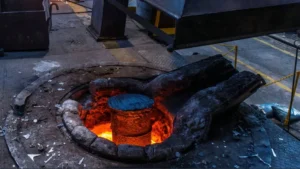এটি একটি অত্যন্ত গুরুত্বপূর্ণ এবং বাস্তবসম্মত বিষয়. Induction furnaces are major energy consumers in the foundry and metallurgy industries. Even minor efficiency improvements can lead to significant cost savings and environmental benefits.

1.Optimize Operating Procedures
This is the most direct energy-saving method at the operational level. Induction furnaces operate at their highest electrical efficiency during full-power melting and at their lowest efficiency when holding at low power.
- Full-Power Rapid Melting: During the melting phase, maintain full power or near-full power (যেমন, above 90%) output as much as possible to convert the solid charge to liquid metal in the shortest possible time. Shortening the melt cycle is the core of energy saving.
- Reduce Holding and Waiting Times: Strictly avoid long periods of low-power holding. Once melting is complete, পরিশোধন, তাপমাত্রা পরিমাপ, sampling, and pouring should be finished as quickly as possible. If waiting is unavoidable, it is more energy-efficient to turn the furnace off (for short periods) than to hold at low power for a long time.
- Maintain a Proper Molten Level: Keeping a high level of molten metal in the furnace (“full but not overflowing”) helps improve thermal efficiency and reduces heat radiation loss from the furnace opening.
2.Schedule Production Reasonably
ক “cold start” is one of the largest energy drains for an induction furnace. Every time the furnace is started from room temperature, a massive amount of energy is consumed to heat the heavy lining, and this heat is lost when the furnace is shut down.
- Centralize Production Runs: Concentrate melting tasks within a single day or a single shift as much as possible. Avoid sporadic production schedules.
- Continuous Operation: The ideal energy-saving model is “continuous melting.” উদাহরণ স্বরূপ, instead of shutting down at the end of a shift, the furnace is handed over to the next shift while hot (hot handoff), or melting is done in continuous batches (one after another) within the same shift.
- Utilize Lining Thermal Inertia: Continuous production makes full use of the heat stored in the lining, allowing subsequent batches to melt faster and consume less electricity.
3.Improve Lining (Refractory) Practices
The furnace lining is the heart of the induction furnace; it serves as the container and is also key to electrical and thermal efficiency.
- Optimize Lining Thickness: A thicker lining is not always better. An excessively thick lining reduces electrical efficiency (poor coupling between the induction coil and the molten metal), increasing energy loss. An excessively thin lining is unsafe. You must find the optimal balance between safety and efficiency based on the furnace’s capacity and design.
- Strict Ramming and Sintering: The lining must be rammed uniformly and densely. The sintering (furnace bake-out) process must strictly follow the temperature curve and timeline provided by the supplier. A poorly sintered lining (incompletely sintered or over-sintered) will have reduced insulation properties and durability, leading to electrical leakage or rapid erosion, which continuously wastes energy.
- Select Appropriate Materials: Use high-quality lining materials with low thermal conductivity, good insulation properties, and high resistance to erosion.
4.Strengthen Charge Material Management
The charge material (স্ক্র্যাপ স্টিল, রিটার্নস, ইত্যাদি) put into the furnace directly determines the time and energy required for melting.
- Increase Charge Density: Use dense materials, such as baled or sheared heavy scrap, whenever possible. Avoid light, bulky, বা “fluffy” scrap. Dense materials absorb magnetic energy more effectively and melt faster.
- Keep it Clean and Dry: Dirt, মরিচা, তেল, and moisture in the charge material consume extra energy during melting (especially water, which requires enormous heat for evaporation and poses a safety risk).
- চার্জ প্রিহিট করুন (Optional): If conditions safely permit (যেমন, using a waste heat channel or a dedicated preheater), preheating the charge (যেমন, to 300-500°C) can significantly shorten melting time and reduce power consumption.
5.Optimize Power & কুলিং সিস্টেম
An induction furnace’s energy consumption isn’t just in the furnace body; it’s also in the supporting power supply and cooling systems.
- Maintain a High Power Factor: Induction furnaces are inductive loads and require capacitor banks for compensation. You must ensure the capacitor bank is working correctly to keep the power factor (PF) উচ্চ (যেমন, above 0.95). A low power factor causes significant reactive power losses (resulting in utility penalties and increased heat).
- Control Cooling Water Appropriately: Cooling water is used to cool the induction coil and power supply, but it inevitably removes heat from the furnace. Optimize the water flow and temperature to avoid over-cooling while ensuring safety. উদাহরণ স্বরূপ, maintaining the outlet water temperature at a reasonably high setpoint (যেমন, 50-60° সে) instead of too low (যেমন, 30° সে) can reduce heat loss.
- Check Electrical Connections: Keep all high-current connection points (bus bars, জল ঠান্ডা তারের) clean and tight to reduce heat loss caused by contact resistance.







